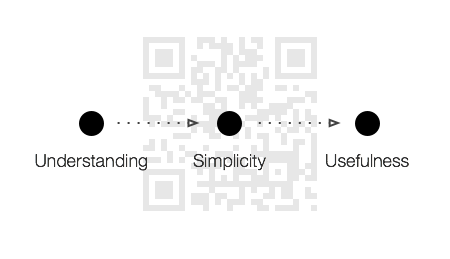QR Codes, Semacodes and other similar technologies are a very tricky topic to address, they’re also subject to quite intense waves of hype that repeat themselves every few years.
The hype in this case isn’t completely unfounded, because creating the connection between the physical and digital worlds is something everyone is aiming for, and something that will be able to trigger huge changes in the manipulation, usage and interaction with services and people.
Where are we coming from?
To understand the reason behind past failures we need to go back to Japan, where in 1994 QR Codes were born. However nothing really relevant happened in QR Code development until 2002, when the top Japanese carriers (NTT DoCoMo, J-Phone) and handset makers (Panasonic, NEC, Sharp) started pushing mobile phones with QR Codes built in. By 2006 almost 100% of mobile users had a QR Code enabled phone.
This means that we cannot use Japan as an example, their technology was already years ahead before they decided to implement QR Code use (the market penetration was already at 100%). Today everyone is familiar with QR Codes and anybody can use them with any mobile phone straight out of the box.
In the past there were companies that tried to explain what QR Codes were, how to use them, which applications to install and the eventual benefits of doing so. Unsurprisingly, this was an expensive practice that didn’t pay off. People just didn’t bother with QR Codes.
So, the only way to market QR Codes was to make them the “next cool thing”, spicing it up so that early adopters would experiment with it.
Most of the analysis made in this specific field were misleading because they didn’t have any comparative value: you either had pure QR Code marketing campaigns (so, no URL for example to see what people would have used in comparison) or both QR Code and URL campaigns which pointed to the same trigger, counting as the same thing. Most of the time the campaigns were well received, but when they lost momentum so did QR Code adoption.
Unfolding Easy

To create the connection between physical and digital worlds we have a few user experience elements that we need to address:
- Understanding: I need to know that I can do something, and what.
- Simplicity: it just works.
- Usefulness: I’ll get something useful out of it.
Understanding can be solved is a very straightforward way: it’s not hard to create a campaign that tells people what a QR Code is. At the same time making it useful depends a lot on the company and the services it wants to offer to the client, it’s not an inherent problem in the usage of QR Code. So if we give these two as granted, what’s left is: simplicity.
To understand better why making it simple is hard we have to compare it to what people are doing right now. Most of the time people are doing one of these two things: noting down the URL/text or taking a photo of it. So, to make it easy we need to optimize the process of QR Code capture, making it more efficient than taking a photo.
Of course, the first step is making sure that everyone has an application to read QR Codes installed. Today, this could be solved by the OS providers or, market pressure great enough to persuade everyone to download an application on their smartphone.
Huge steps could be made here, but it’s completely in the hands of mobile OS designers (Apple, Google, HP, Nokia, Samsung, Intel, etc): the ideal scenario would be something like a built-in service inside the default camera application: when the camera detects a QR Code, it shows an interactive dot on the screen that you can tap.
This solution will also solve the second problem: the application needs to be the quickest solution possible, it could be quicker than a camera if you don’t even have to take the photo: you point at it and it’s there. It just works.
There are already applications that do this: Bakodo is a free iPhone app and Google Goggles is a multifunctional tool for Android and iPhone that also uses realtime QR Code recognition.
What can be done?
Unfortunately these problems are currently outside the control of businesses, so what can be done?
A good starting point is to address the three elements I explained above:
- Understanding: create a campaign or a service that quickly explains to the user what they should do, and why.
- Simplicity: study the quickest ways of enabling the user to bridge the gap between the physical and digital world in the specific scenario you are building.
- Usefulness: give value to your user to compensate for the effort they contributed.
Note that the “compensation” is reduced the more that element 1 and 2 are considered, simpler and quicker, but today probably isn’t time to give lower-value content, or content that people are already happy to get elsewhere. When this “connection” becomes more transparent there won’t be any problem and these suggestions will be less relevant, but today you have to take extra care.
As Jed was saying a few days ago, this is the right time to drive adoption through experimentation, and be prepared for the future.
The future
We need to understand that QR Codes are just one of the many choices ahead of us to bridge the gap between physical and digital. In recent years many projects have tried to do just that, from smart sensors to smart cameras, from mesh protocols to glasses.
The two following emerging technologies are very interesting and worth researching, and even experimenting with in the future.
Augmented Reality (AR) is a term that includes many techniques to bridge the gap, usually adding virtual contents to the physical world. To use with this today you need to download a specific application which you then use to point at a special tag. A similar chicken-egg problem we have with QR Codes, however the interesting part is that they might be connected to QR Codes as well, and may not require anything at all to be used, just more computing power and detection algorithms.
Another interesting contact point will be the upcoming NFC technology. A technology that like QR Codes was tried a few times – most notably by Nokia – which was adopted in Japan as a payment system – again, thanks to top-down pushes. Now the protocol seems more standardized and bigger companies like Google are including NFC support and development tools inside their operating systems.
The future is difficult to predict, but experimenting with these is already possible with good results, be just sure to set your expectations right.
Updates
- Sean X Cummings (10/2011) “Why the QR Code is failing”.
As I hinted above, there were a few waves coming from various industries that tried to make people adopt QR Codes “like in Japan”. The last one seems today happening in USA, and again, it’s failing. This article looks like a mirror of mine, with another excellent perspective. - Eismann Oreilly (10/2011) “QR Codes Viruses: Should we panic?”.
Lack of transparency is a big issue, and here’s a good explanation of a what could happen due to this.
